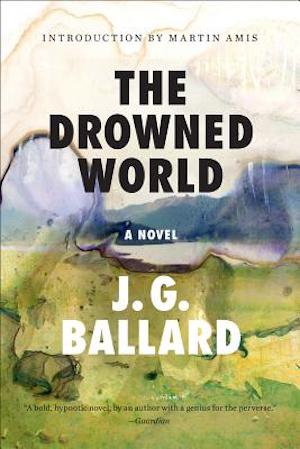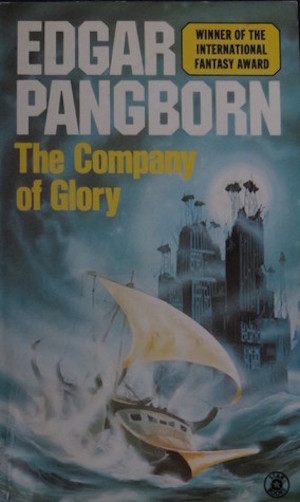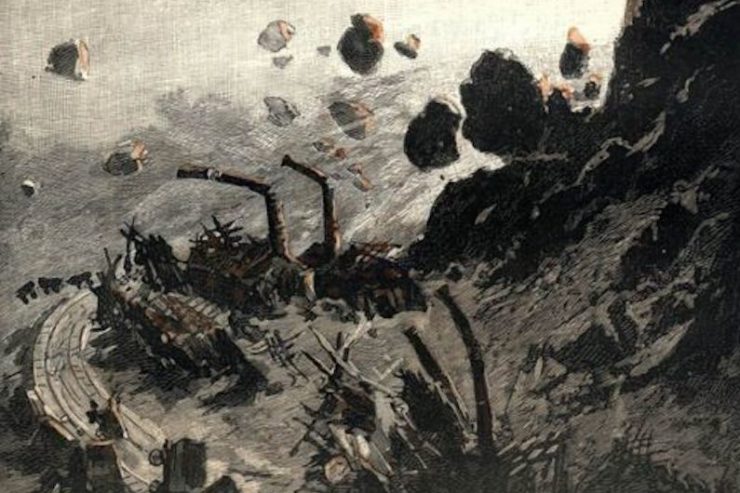Every January, as I wade hip-deep through snowdrifts, I marvel at the sequence of decisions that led my family to blustery Ontario from delightful Maui. Perhaps “marvel” isn’t the word; I do tend to wonder “what the heck were they thinking?”
When I yearn for year-round tropical weather, sometimes I think that a temporal move, into the past, might be just as good as a spatial move. There was, after all, a glorious moment in Canadian pre-history known as the Paleocene–Eocene Thermal Maximum. Were I there, I could really enjoy the weather (that is, if I could bring civilization and its comforts with me). But…if I could live long enough I might well get to enjoy a decently tropical Canada. Modern-day humans seem reluctant to reduce or even slow their contributions to atmospheric CO2. Climate change, here we come!
While global warming is unsurprisingly a tremendous source of inspiration for modern-day science fiction writers, the current era does not have a monopoly on the subject. There were many works of Disco Era (and even earlier) SF that played with the dramatic potential of abrupt, dramatic climate change. Consider these five examples…
The Purchase of the North Pole by Jules Verne (1889)

Some might deem the land rights from the 84th parallel to the North Pole nearly valueless, protected from exploitation as they are by the demanding conditions of the Arctic. Barbicane and Company have come up with a bold scheme to develop the Arctic, using the same basic technology (cannons of unusual size) that sent men past the Moon twenty years earlier. The former members of the Baltimore Gun Club plan to construct an enormous cannon on the slopes of Mount Kilimanjaro, one whose recoil will reduce the Earth’s obliquity to zero. This rather Alexander Abian-esque ploy will warm the Arctic and make it possible to mine the vast coal beds now owned by the company.
The aftershock of such a huge gun will rattle the Earth, tumbling buildings to the ground. Low-lying regions in Asia will be inundated. The death toll could be incalculable. However, the visionary American directors of the company will not be deterred by trifling externalities. They may, however, be confounded by a minor problem in implementation.
The usual warning about translations of Verne’s work applies. Still, if you’d like to read a novel about exuberant Americans who absolutely refuse to let petty objections like the welfare of other nations prevent them from transforming the world in various useful ways, this is the 19th-century novel for you.
The Drowned World by J. G. Ballard (1962)

In Ballard’s tale, blame for global warming falls not on humans but on the Sun. Lashed by unprecedented solar storms, the Earth is transformed from a temperate world to a hot and wet one. Populations are forced to migrate poleward in search of tolerable conditions.
Despite the chaos of the era, scientific curiosity persists, along with surviving organizations that can mount expeditions to satisfy said curiosity. Thus, Colonel Riggs’ expedition to dampest London. The intention is to catalog the flora and fauna of the vast swamp now occupying the site of England’s former capital. This being a Ballard novel, the marvels discovered will be…unexpected.
Standard Ballard warning applies: at some point you may ask “Was the author on drugs when he wrote this?” To which I can only answer “I don’t know.” British New Wave SF, of which this is a fine example, often gives that impression. But surely there cannot have been enough drugs in England to supply the whole of the New Wave?
The Company of Glory by Edgar Pangborn (1975)

Half a century after 1993’s Twenty Minute War, the Darkening World is well on its way to becoming the setting for Pangborn’s better-known novel Davy. Those who survived the War were further winnowed by the pandemics that followed. Abrupt warming drove inundation of coastal areas by rising seas. Where America once ruled, ignorant petty kingdoms like Nuber now dominate.
Storyteller Demetrios’ keen grasp of history makes the old man inconvenient to Nuber’s rulers. Demetrios, seeing which way the wind is blowing, becomes a new Moses and leads a party of hopeful pilgrims out from Nuber, in search of a new home and a better way of life. This does not end well.
Pangborn’s Darkening World books tended to balance hope for individuals with despair for humans as a whole. As Pangborn grew older, his books grew bleaker. This is a late-career book.
The Road to Corlay by Richard Cowper (1978)

The first section of the book is set in 1986. The scientists of the time note that the climate is changing and the seas are rising. They are sure, however, that climate normalcy will eventually reassert itself. Not so. The story resumes in the Fourth Millennium, after rapid warming has led to inexorable disaster and the death of five billion.
Britain a thousand years hence is a thinly populated archipelago whose backward inhabitants are shepherded by a blinkered church. Young Tom’s musical gifts have the potential to inspire a new faith and thus transform the world. He does not fulfill this promise—he’s killed by the church, then touted as a martyr to the faith.
I was rather surprised to encounter this passage in a book of this vintage:
The Drowning was the direct result of humanity’s corporate failure to see beyond the end of its own nose. By 1985 it was already quite obvious that the global climate had been modified to the point where the polar ice caps were affected.
This novel isn’t all that plotty; it’s a sometimes-languorous tour of a world transformed by anthropogenic climate change. If I were to read the other two books in the series, perhaps I would discover a plot. Or perhaps not. Perhaps Cowper rejected conventional plot structure.
Islands by Marta Randall (1976)

The Great Shaping transformed the world. It was not a kindly process; billions died (especially those who had lived at the former sea level). As apocalyptic as the Great Shaping was, there were survivors. By the time of the novel, the survivors have not merely prevailed. They have created a civilization capable of wonders that are to us mere science fiction.
One of those wonders is the Treatment, which gives humans a lifespan limited only by accidents. Protagonist Tia Hamley is the one human who is immune to the Treatment. She will die in a mere century or so.
To distract herself from imminent death, she joins a party exploring the submerged Hawaiian islands. One member of the party decides to hasten Tia’s death. Will she survive?
This novel is rather New Wave, rather experimental. It’s also rather ableist. In part this reflects the unthinking ableism of the times in which it was written. But it can also be seen as a reflection on the way that we humans tend to avoid thinking about disability and death. Even people given the Treatment will die eventually (accidents); Tia is an unwelcome reminder of that fact.
***
There are many books I could have but did not mention (Heat and A Fond Farewell to Dying being but two). Perhaps readers have their favourites they would like to champion. Comments are, as ever, below.
In the words of fanfiction author Musty181, prolific book reviewer and perennial Darwin Award nominee James Davis Nicoll “looks like a default mii with glasses.” His work has appeared in Publishers Weekly and Romantic Times as well as on his own websites, James Nicoll Reviews (where he is assisted by editor Karen Lofstrom and web person Adrienne L. Travis) and the 2021 and 2022 Aurora Award finalist Young People Read Old SFF (where he is assisted by web person Adrienne L. Travis). He is a four-time finalist for the Best Fan Writer Hugo Award, and is surprisingly flammable.










